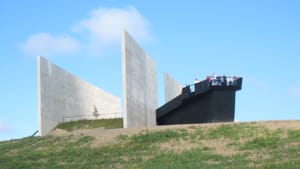Stay in the Loop
BSR publishes on a weekly schedule, with an email newsletter every Wednesday and Thursday morning. There’s no paywall, and subscribing is always free.
Reclaiming the site of a tragedy
The Flight 93 National Memorial

The leaves were already changing color along Lincoln Highway (US Route 30) in southwest Pennsylvania as I drove toward Shanksville. It was 11 days after the opening of the Flight 93 National Memorial, which honors the 40 persons who engaged in valorous action during the hijacking of United Flight 93 on September 11, 2001.
What was once a meadow, then a barren stretch in the wake of coal mining, and then a charred crash site has been transformed by virtue of sensitive and meaningful design. The result is a glorious work of art that blends architectural structures and crafted landscape to create a contemplative place for visitors and a resting place for those who died. The components of this glory are marble, granite, vistas of wild flowers, a pond with waterfowl, hills of trees, and winding pathways. A red barn occupies a rise in the distance. Farther away is a field of windmills looking like slim three-petal flowers in a land of giants.
Subtle metaphors
I began my tour at Memorial Plaza, strolling a walkway, bordered by a low-slanting black granite wall that passes the crash site (open only to family of the deceased). At the end of the walkway looms a white-marble wall of names consisting of 40 panels, each inscribed with the name of one of the 2 pilots, 5 flight attendants, and 33 passengers who died. Moving slowly along the wall brings tears.
The whole wall, from left to right, points to a sandstone boulder bordered by hemlocks. The boulder, viewable through a Ceremonial Gate made of hemlock wood, sits on the edge of the impact site: The wall demarcates the last several yards of the plane’s flight path, upside down and traveling at more than 550 miles per hour before it slammed 10 feet into the earth.
The visitors’ center offers revelations beyond a gift shop. Architect Paul Murdoch’s elegant capacity for subtle metaphor is detectable. Outside, there is the dignity of a walkway that guides the visitor between two massive curving walls of etched white rock demarcating the flight path. The curves terminate in a platform, shaped like the nose of an airplane, from which one can view the boulder that marks the point of impact. Jutting from the outside surface of the far white wall is a V-shaped protrusion of glass, supported top and bottom by a sideways metal V, conjuring a cockpit, with the soaring walls themselves suggesting the body of an airplane.
Farewell phone calls
Inside the main building, 10 high partitions are configured like rows of airplane seats. Through a variety of media, each partition, taken in sequence, tells a vivid piece of the unfolding story of 9/11. Here one may cry anew, seeing the ever-poignant sight of one plane and then another hitting the twin towers. Here one may listen to farewell phone calls from aboard Flight 93, each expressing “I love you,” recorded on home answering machines: a passenger to her husband (there’s a little trouble on the plane but I’m fine and you’re not to worry); a passenger to her sister (the plane has been hijacked and here’s the code to the safe in my bedroom); and a flight attendant to her husband (the plane has been taken over by terrorists and I hope to see your face again).
From the visitors’ center, I walked an alternate path back to Memorial Plaza. The way wound past 40 groves of saplings and sloped downhill to a rust-colored constructionist bridge across the pond, which offers a splendid view of the white walls on the hill above. Altogether, this land that had been depleted of life through strip mining and was momentarily rendered a charnel ground through terrorist attack, is becoming, through reclamation, a verdant oasis and an unadorned shrine.
The other four
The creators of the memorial have chosen to obliterate the four Al-Qaeda men whose nefarious activities brought about the suffering on Flight 93. The educational exhibits and brochures repeatedly refer to 40 persons on the plane: 33 passengers and 7 crew members. One exhibit presents two lovely photos of each of the 40 passengers and crew members, and another gives their seat numbers. But there were 44 people on the plane, and 44 people died. The memorial seems to be saying the Al-Qaeda men were not only non-passengers but also non-persons. But they too had names and seat numbers. Their DNA, along with the DNA of the 40 people they murdered, was found in the wreckage. They should not be memorialized, but they ought to be counted among the dead.
I’ve seen British writer/director Paul Greengrass’s disturbing real-time film, United 93, three times, though none of my friends would go with me when it came out in 2006. The film did well commercially and won the BAFTA for best director, but it may have arrived too soon for many Americans to appreciate. Unlike the memorial, United 93 allows us to see imaginatively into the minds of the terrorists. It’s a hard thing to look at but valuable to fathom, for the sake of our maturity and emotional intelligence.
On my return from Somerset County, I avoided the turnpike and drove the 200+ miles entirely on historic Route 30. The road curved up and down the heights of the green Allegheny Mountains, stretched through vast Pennsylvania farmland, bisected the battlefields of Gettysburg, snaked toward Philadelphia through populous suburbs, and brought me safely home.
What, When, Where
Flight 93 National Memorial. 6424 Lincoln Highway, Stoystown, PA.
United 93, written and directed by Paul Greengrass. Available on Netflix.
Sign up for our newsletter
All of the week's new articles, all in one place. Sign up for the free weekly BSR newsletters, and don't miss a conversation.
 Joanna Rotté
Joanna Rotté